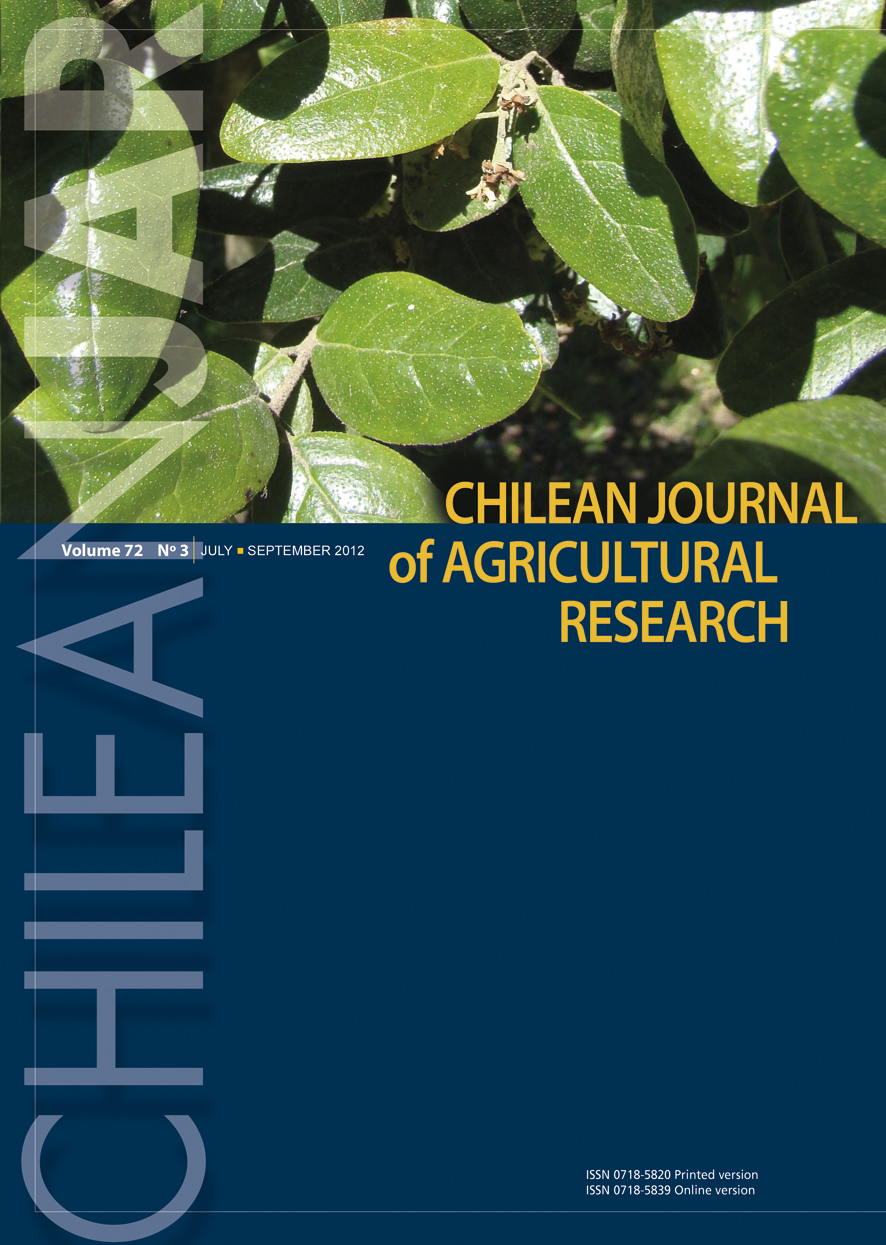
|
Chilean Journal of Agricultural Research
Instituto de Investigaciones Agropecuarias, INIA
ISSN: 0718-5820
EISSN: 0718-5820
Vol. 70, No. 4, 2010, pp. 545-551
|
 Bioline Code: cj10060
Bioline Code: cj10060
Full paper language: English
Document type: Research Article
Document available free of charge
|
|
|
Chilean Journal of Agricultural Research, Vol. 70, No. 4, 2010, pp. 545-551
| en |
Management of Auxin-Cytokinin Interactions to Improve Micropropagation Protocol of Henequen (Agave fourcroydes Lem.)
Caraballo, Miguel Garriga; Oramas, Gerardo González; García, Silvia Alemán; Cruz, Enildo Abreu; Bravo, Karla Quiroz; Caligari, Peter D.S. & García-González, Rolando
Abstract
Henequen (Agave fourcroydes Lem.) is a high value plant species both for agricultural and ecological uses. The species is very well known worldwide by the quality of its fiber that is widely used for industrial purposes. This species is propagated at a large scale by asexual methods but current propagation technologies are not satisfying the grower's demands. A. fourcroydes has been cultivated in vitro but it has shown some recalcitrant behaviour during the multiplication and rooting stages. The combination of 6-benzylamynopurine (BAP) (0.75 mg L-1) and indolebutyric acid (IBA) (1.0 mg L-1) instead of 2,4-dichlorophenoxyacetic acid (2,4-D) significantly improved explant survival and shooting during the establishment of in vitro young shoots. Combining thidiazuron (TDZ) (0.5 or 0.75 mg L-1) with BAP (1.0 mg L-1) and IBA (1.0 mg L-1) in the basal medium increased the multiplication rate of henequen and significantly speeded out bud dormancy breaking. To improve rooting of the micropropagated shoots, the addition of IBA and naphthylacetic acid (NAA) was tested. The best rooting efficiency was obtained when the basal medium was supplemented with 0.5 or 0.75 mg L-1 of NAA, giving 100% of rooted explants and an average of 9.40 and 11.55 roots per explants, respectively. Over 94% of micropropagated plants survived the ex vitro weaning step and no morphological disorders were observed in any of the plants. Modification of plant growth regulators composition in the medium was a key factor to improve the efficiency of the micropropagation technology of henequen.
Keywords
Agave fourcroydes, propagation, thidiazuron, 6-benzylamynopurine, in vitro culture.
|
| |
| es |
Manejo de la Interacción Auxina-Citoquinina para Mejorar el Protocolo Micropropagación de Henequén (Agave fourcroydes Lem.).
Caraballo, Miguel Garriga; Oramas, Gerardo González; García, Silvia Alemán; Cruz, Enildo Abreu; Bravo, Karla Quiroz; Caligari, Peter D.S. & García-González, Rolando
Resumen
El henequén (Agave fourcroydes Lem.) es una especie vegetal de gran valor agrícola y ecológico conocida mundialmente por la calidad de su fibra usada con fines industriales. Esta especie se propaga a gran escala por métodos asexuales, pero las tecnologías de propagación actuales no son capaces de satisfacer la demanda de los productores. A. fourcroydes ha sido propagado in vitro pero muestra comportamiento recalcitrante durante las fases de multiplicación y enraizamiento. En este estudio se demostró que la combinación de 6-benzilaminopurina (BAP) (0.75 mg L-1) y ácido indolbutírico (IBA) (1.0 mg L-1), en lugar de ácido 2,4-diclorofenoxiacético (2,4-D), mejoró significativamente la supervivencia de los explantes y la brotación durante la fase de establecimiento in vitro a partir de brotes jóvenes. La combinación de thidiazuron (TDZ) (0.5 ó 0.75 mg L-1) con BAP (1.0 mg L-1) e IBA (1.0 mg L-1) en el medio basal incrementó la tasa de multiplicación del henequén y aceleró la ruptura de la dormancia de las yemas. La mayor eficiencia de enraizamiento se obtuvo cuando el medio basal fue suplementado con 0.5 o 0.75 mg L-1 de ácido naftalenacético (NAA), obteniéndose un 100% de plantas enraizadas y un promedio de 9.40 y 11.55 raíces por planta. El 94% de las plantas sobrevivió el proceso de aclimatización ex vitro y no se observaron desórdenes fisiológicos en ninguna de las plantas. La modificación de la composición de reguladores del crecimiento vegetal en el medio de cultivo fue un factor clave para mejorar la eficiencia de la tecnología de micropropagación de henequén.
Palabras-clave
Agave fourcroydes, propagación, thidiazuron, 6-benzilaminopurina, cultivo in vitro.
|
| |
© Copyright 2010 Chilean Journal of Agricultural Research.
Alternative site location: http://www.inia.cl
|
|
